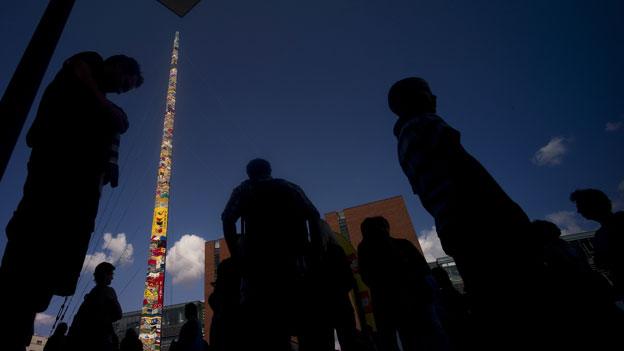How tall can a Lego tower get? (original) (raw)

Image caption,
Building Lego towers is a competitive business - this one in Prague, at 32.5m, may be the tallest to date
It's not just children who like to build towers with Lego - the internet is alive with discussion on how many Lego bricks, stacked one on top of the other, it would take to destroy the bottom brick. So what's the answer?
There has been a burning debate , externalon the social news website Reddit.
It's a trivial question you might think, but one the Open University's engineering department has - at the request of the BBC's More or Less programme - fired up its labs to try to answer.
"It's an exciting thing to do because it's an entirely new question and new questions are always interesting," says Dr Ian Johnston, an applied mathematician and lecturer in engineering.
Looking on the internet, he expected to find the answer, but was surprised to find only a lot of speculation.
Perhaps that's because not everyone who has pondered the question has ready access to a hydraulic testing machine.
The 2x2 Lego brick looks vulnerable, placed on top of a metal plate, which a hydraulic ram is pushing upwards. On top of the brick is a second plate, with a load cell on top of it, measuring the force being exerted.
Safety glasses on, the engineers begin to nervously edge towards the door.
"We're setting it up automatically, so that we can all back out of the room, so none of us is in range when the thing goes bang," Johnston explains - positioned, I notice, slightly behind me.
And the load on top of the brick gets larger and larger. We reach 3,500 newtons (N) of force - the equivalent of having 350kg (770lbs) sitting on top of the brick - more than a third of a tonne.
The force climbs on, above 4,000N. And then...
Nothing.
Well, not much. There is no big bang. The brick just kind of melts.
It looks like a small square of warm camembert.
This, Ian Johnston explains - noting that the computer also shows the load is no longer increasing - is a "material failure".
"The material is just flowing out of the way now and it's not able to take any more. We're getting a plastic failure. It means the brick keeps on deforming, without the load increasing. Metals can be plastic, and this plastic is being plastic," he says.
So - how many Lego bricks, stacked one on top of the other, would it take to destroy the bottom brick?
Ian Johnston and the team do two more tests to be sure we hadn't just happened upon the strongest Lego brick in existence. And in fact they were impressed at the consistency of Lego manufacture.
The average maximum force the bricks can stand is 4,240N. That's equivalent to a mass of 432kg (950lbs). If you divide that by the mass of a single brick, which is 1.152g, then you get the grand total of bricks a single piece of Lego could support: 375,000.
So, 375,000 bricks towering 3.5km (2.17 miles) high is what it would take to break a Lego brick.
"That's taller than the highest mountain in Spain. It's significantly higher than Mount Olympus [tallest mountain in Greece], and it's the typical height at which people ski in the Alps," Ian Johnston says (though many skiers also ski at lower altitudes).
"So if the Greek gods wanted to build a new temple on Mount Olympus, and Mount Olympus wasn't available, they could just - but no more - do it with Lego bricks. As long as they don't jump up and down too much."
The tallest Lego tower... in theory
A 2x4 brick would fail sooner, Ian Johnston reckons, while a 1x2 brick would likely be able to withstand more.
But could a 3.5km Lego tower really be built?
"There isn't a chance you could do it in reality," Johnston says. "Long before the brick fails, the tower would fail as a structure itself, by buckling. The other thing you have to remember is that we were very careful to load this equally down the middle, so that all four walls were loaded."
A 3.5km tower would have to be built so straight that it was no more than 2mm off centre at the midway point, he says.
"And I'd be delighted to meet a Lego builder who could make a 3.5km tower so accurately."
Cue Duncan Titmarsh, the UK's only certified Lego builder - and one of only 13 worldwide - and Ed Diment, his partner at company Bright Bricks.
They built the 12.2m (40ft) Lego Christmas tree that stood in London's St Pancras station last Christmas, and the 5m x 3m advent calendar standing in Covent Garden.
Do they think they could take up the challenge? No.
"If you try stacking 2x2 bricks as soon as you get beyond 3 or 4m tall there's almost no way you can take out all of the kinks," Ed Diment says.
"So it would be totally structurally impossible to do it, whilst it's an interesting theory."
Real life can be so disappointing sometimes.
Listen to More or Less on BBC Radio 4 and the World Service, or download the free podcast.
You can follow the Magazine on Twitter, external and on Facebook, external
Related internet links
The BBC is not responsible for the content of external sites.